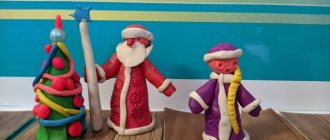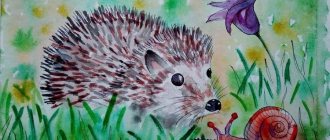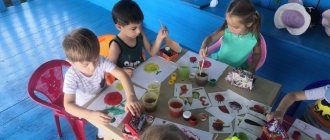Summary of the OD lesson in the middle group “Space flight”
FCCM in the middle group "Space flight"
Goal: consolidating children's knowledge about space Objectives: Educational: • nurturing love for one's planet, • attentive attitude towards people, • pride in the achievements of one's people. Educational: • expand children’s ideas about the world around them (space), • introduce children to the concepts of “sun”, “moon”, “month”, “space”, “star”, “cosmonaut”, “space suit”, “rocket”; • form an initial idea of the Solar System. Developmental: formation in children of a holistic picture of the world, Develop cognitive activity and interest in understanding the world around them Integration of areas: • Cognition • Reading fiction • Physical education • Speech development • Artistic and aesthetic development Equipment and materials: • Globe • Space-themed photos • Puzzles on the topic: “Space” • Dienesh blocks
Progress of the lesson
(On two tables there are puzzles with images of space. The teacher invites the children to assemble them) Educator: Guys, what do you think we will talk about today Children: About space Educator: Do you know what Space is? (children's answers) Educator: Space is very high, where the Earth's airspace ends, outer space begins. Birds don't fly there. Planes cannot fly there. The sky there is completely black. There is no air in space. Guys, what is there in space? Let us solve the riddles: Peas are scattered across the dark sky, Colored caramel made from sugar crumbs, And only when the morning comes, All the caramel will suddenly melt. (Stars) In space, an object flies through the thickness of the Icy years. Its tail is a strip of light, And the object’s name is... (Comet) This bird has no wings But you can’t help but marvel Only when the bird spreads its tail And rises to the stars (Rocket) Educator: Guys, why do people need rockets?” (children's answers) Educator: People need this unique aircraft to explore space, other planets, and search for planets suitable for human habitation. (Showing photos of rockets) Educator: Guys, what is the name of the person who controls the rocket (cosmonaut). An astronaut has a special suit for space flights and this suit is called a spacesuit. (Showing an image of a spacesuit) A person needs a spacesuit for protection. Why does a person need protection in space? Educator: Two dogs were the first to fly into space: Belka and Strelka. Only after they returned safe and sound, Yuri Alekseevich Gagarin was able to go on a space journey and circle around our entire Earth. He made his flight on April 12, 1961 on a Vostok rocket. Since then, this day has been celebrated in our country and it is called Cosmonautics Day. (Showing a photo of Gagarin) Educator: Guys, now listen to a poem about Yu. Gagarin. In a space rocket with the name “Vostok” He was the first on the planet to rise to the stars. Spring Drops sings songs about this: Gagarin and April will be together forever. Educator: Guys, what do you need to do to become an astronaut? (children's answers) That's right, guys, you need to lead a healthy lifestyle, eat right, play sports, do well at school and college. Let us turn into cosmonauts - and repeat the feat of Yuri Gagarin and fly around our planet. So what will we use to fly into space, we don’t have a rocket? Let us build a rocket together. I offer you the material for its construction. (Children build a rocket from Dienesh blocks, space music sounds). Educator: Guys, imagine you are astronauts, but before you go on a flight, we need physical training. Fizminutka: We are going to the cosmodrome, We walk in step together. Children walk in a circle.
We walk on our toes, We walk on our toes.
We're walking on our heels. They walk on their heels.
Here they checked the posture. Stop facing in a circle, hands on the belt.
And the shoulder blades were brought together. The shoulders were turned, the shoulder blades were brought together.
Don't yawn around, you are an astronaut today! Turns the head left, right.
Educator: Guys, take your seats in the rocket, let's start the countdown: 5, 4, 3, 2, 1¬- START! Let's hold on tight until our rocket goes into outer space. Here we are in space. Let's look through our porthole. (Showing the globe) I see some kind of planet - this is the earth. Let's listen to the sounds of our earth from space. (Audio recording of nature sounds) Guys, why is our planet so blue. Children: There is a lot of water on it. Educator: What is special about our planet? Only on our planet do flowers grow, trees only on our planet there are animals and us. What other planets do you know? Children: Mars, Jupiter Educator: There are other planets in space. Listen to a poem about them: An astrologer lived on the moon. He kept track of the planets: One - Mercury, Two - Venus, Three - Earth, Four - Mars. Five is Jupiter, Six is Saturn, Seven is Uranus, Eight is Neptune. And behind it, then, is the ninth planet called Pluto. Educator: Guys, let's repeat the poem together and remember what planets there are. (Memorizing a poem) Educator: Oh oh oh, there’s some kind of gray ball there ahead. Guys, guess the riddle: At night I walk across the sky, Dimly illuminating the earth. It's boring, I'm bored alone, And my name is... (Moon) Educator: At what time of day do we see the moon? Guys, the moon is a satellite of the earth. The Moon has one wonderful feature: it changes its appearance every day. Either it appears like a narrow crescent, then it is called “the month” (showing a photo of the month), then it looks like a pancake, they say about it: “full moon” (showing a photo of the moon). It's getting too hot. Guess the riddle: A yellow plate hangs in the sky. The yellow plate gives everyone warmth. (Sun) Educator: Guys, we are flying past our sun. (Photo of the sun) Guys, what a sun (yellow, round like a ball, hot, if you fly too close you can burn). Well, it’s getting hotter and we need to return to our planet (as it’s called). (“We’re coming back” to the song from the cartoon “Smeshariki” “On a Round Planet”) Educator: Five, four, three, two, one - we’ve landed! Hooray! Did you enjoy our trip? Who can tell me what profession we met today? Children: Cosmonaut Educator: What holiday is celebrated in April? Children: Cosmonautics Day Educator: Well done! Now let's draw what we saw during our flight. (Drawing based on an individual plan.) Exhibition of works.
Middle group. Junior preschool age. Children 4 - 5 years old
Summary of the lesson “Space travel to the planet Hemofiguryat” for middle-aged children 4–5 years old Summary of the implementation of the educational field “Cognitive Development”
through direct educational activities on the topic
“
Space travel to the planet HEMOFIGURE” for middle-aged children (4-5 years old. Author: Irina Anatolyevna Kudryavtseva. Description of the material….
Notes for the lesson “Space Adventure” in the middle group Notes for an open lesson on design in the middle group . " Space Adventure "
Goal: Development of cognitive and creative activity of children on the topic
“
Space ” Objectives: 1. Form the concept of
space . 2.learn to create a cosmic composition . 3.Form creative…
Progress of the conversation:
Guys, have you ever looked at the sky? What did you see there?
People have been looking at the sky and admiring the stars for a long time. They are very
I'd be interested to know what they are. Do you want to know about the stars?
To learn about the stars, people built a space rocket . AND
dogs to be sent into were Belka and Strelka, and when they returned,
people also wanted to get closer to the stars. Next look at
Yu. A. Gagarin went to the stars - this is the first cosmonaut .
It's very, very cold in space If you go into space without
special suit - you can instantly freeze and turn into
ice. In addition, there is very little air in space and an ordinary person there
won't be able to breathe. That is why the astronaut who flew to
space , put on this spacesuit. The suit is very warm and protective
an astronaut from the cold even in space . In addition, there is a man in a spacesuit
can breathe - it supplies a person with air.
When the astronaut got into the rocket , the countdown began: “Five, four,
three, two, one, GO!” The rocket took off, fire came out of its tail - so
her engine was working hard. And the rocket flew high into the sky. She
rose higher and higher. And so the rocket ended up in outer space .
Look what the astronaut when he found himself in it.
This is our planet Earth - we live on it. As you can see, she
round and looks like a big ball. Our planet is very, very large.
That's why we don't notice that it looks like a ball. But if you rise above
the earth high, high - then from space we will see it like this
Look how beautiful our planet is!
What do you think is blue on our planet? (children's answers)
.
What's green? Brown? (children's answers)
Look, this is a small ball near the earth - the moon. Moon
much smaller than the earth and in space it also looks like a ball.
And this is how the astronauts saw our Sun. Huge
glowing fireball. But astronauts cannot
they could - because the Sun is very, very hot. If you get close to him
too close and you might even get burned.
And the astronauts saw other planets that were rotating
around the sun. Look, this picture shows all the planets,
which revolve around the Sun. Notice how huge our
Sun! It is larger than all other planets! And our planet Earth is
she is the third from the Sun - very small compared to others
planets. All planets in the solar system revolve around the sun
its orbit. On those planets that are very close to the Sun - very
hot! We couldn't have stayed there for even a second! And at the farthest
planets - which are far from the Sun - on the contrary, are very cold, because
the sun's rays do not reach there well.
In this picture you can see what different sizes there are.
planets and how big our Sun turns out to be. From the Earth the Sun to us
it doesn't seem that big because it is very far from us. Actually
in fact - that's how huge it is!
And around the planets the astronauts saw small luminous balls,
looking like little suns, they were stars. Let's go with you too
That's how many interesting things the astronauts learned about space .
Let's fly to the stars easily! Application It is no secret that preschool children find the theme “Space” extremely interesting. Before Cosmonautics Day, they get the opportunity to learn a lot.
Source
What to tell your child about space (middle group)
Lydia Kolobova
What to tell your child about space (middle group)
There are 8 planets in the solar system. They all revolve around the Sun, constantly along the same path, which is called an orbit. And one of these planets is our Earth. The sun is a large and very hot star, a huge, hot ball. It is very far away, but the heat from its rays reaches all the planets circling around it, and ours too. That's why it's warm here. The moon is a satellite of our planet; it is only three days away. The Moon moves around the Earth counterclockwise.
Our planet is surrounded by an atmosphere. This is a protective layer that saves inhabitants from solar ultraviolet radiation, as well as from most meteorites. It can be compared to a blanket of air. It is thanks to him that our planet has the air that we breathe.
It is believed that the rest of the space is lifeless. The belief and desire of people to find life on other planets forces us to design spaceships to travel into space in order to study it.
You can get creative with your children and make aliens.
There are only 8 planets in the solar system. The largest of them is Jupiter. And the most interesting is Saturn, because it has huge rings around it.
Jupiter, Uranus and Neptune also have rings, but they cannot be seen from Earth.
On April 12, our country celebrates Cosmonautics . On this day in 1961, people's dream of flying into space cosmonaut in history, Yuri Alekseevich Gagarin, flew into space on the Vostok-1 spacecraft. Its flight around the Earth lasted 108 minutes. Since then, every year on this day we celebrate Cosmonautics .
Let's make our own rockets!
Consultation “What to tell 6-7 year old children about space?” Space for preschool children, such an interesting topic. Let's try to tell children about space as clearly and interestingly as possible.What to tell children about Maslenitsa Maslenitsa is a cheerful and life-affirming holiday of seeing off winter and welcoming spring, which is celebrated with pleasure by both children and adults.
What to tell children about Maslenitsa! About Maslenitsa - for children Maslenitsa is one of the most fun holidays in Rus'. This is a kind of traditional cycle (lasting a week) of seeing off winter and...
Consultation “How to tell a child a fairy tale” A small child loves to listen to fairy tales. But it is much more interesting not only to read a fairy tale, but also to show illustrations to the fairy tale. Today there is.
Consultation for parents “October 20 is the day of the Primorsky Territory. What’s interesting to find out for yourself and tell to your child” Primorye - May’s small homeland October 20 Primorye Day What’s interesting to find out for yourself and tell to your child: LEGENDS AND TRADES OF PRIMORYE Legend.
Consultation for parents “May 9. How to tell your child about the Great Victory Day” Goal: Improving educational work; strengthening its patriotic orientation; formation of the foundations of the national.
Consultation for parents “What to tell your child about Maslenitsa” DEPARTMENT OF EDUCATION OF THE ADMINISTRATION OF THE CITY OF TYNDA MUNICIPAL PRE-SCHOOL EDUCATIONAL BUDGETARY INSTITUTION “KINDERGARTEN No. 6 “CHERYOMUSHKA”.
Consultation for parents “What to tell your child about Easter?” DEPARTMENT OF EDUCATION OF THE ADMINISTRATION OF THE CITY OF TYNDA MUNICIPAL PRE-SCHOOL EDUCATIONAL BUDGETARY INSTITUTION “KINDERGARTEN No. 6 “CHERYOMUSHKA”.
Consultation “Non-childish conversations: how to tell a child about death?” Non-childish conversations: how to tell a child about death? In every family, sooner or later there comes a time when the child begins to ask questions.
Thematic conversation “Man in Space” for children of senior preschool age (secondary and preparatory groups) Goal: to expand and deepen preschoolers’ knowledge about space. Objectives: to consolidate children's knowledge that the first person to fly into space.
Source



